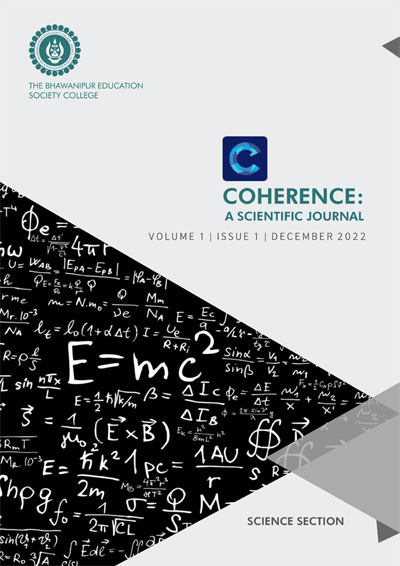Coherence: A Scientific Journal
Journal of the Science Section
‘Coherence: A Scientific Journal’ is a peer-reviewed Journal undertaken by the Science Section of The Bhawanipur Education Society College, Kolkata, West Bengal, India. It covers all Science subjects, like Physics, Chemistry, Mathematics, Computer Science, Electronics, Economics, Statistics, Material Sciences, Engineering and Technology, Earth and Planetary Sciences, Agricultural Sciences and Bio-molecular Sciences, Health Sciences, Microbiology, Immunology, etc.
Around the globe, research energizes scientific progress but how we share new knowledge is changing. What are the challenges of the digital era? What do researchers think about the constantly evolving landscape? How will technology shape the science we create? And what steps should we take to ensure that curiosity-driven research continues to unlock new opportunities in unexpected ways? “Coherence: A Scientific Journal tries to address these questions.”
Details of the Journal
Name of the Journal – Coherence: A Scientific Journal
Starting Year of Publication – 2022
Volume-1, Issue-1 Published in December, 2022
Publication Frequency – Annual
Format/ Medium – Online Journal (Completely open-access journal without any
subscription charges)
Language – English
Subject – All Science Subjects
Publisher – Dr. Subhabrata Ganguly, Teacher-in-Charge, The Bhawanipur Education
Society College. 5 Lala Lajpat Rai Sarani, Kolkata- 700 020, West Bengal, India.
Call For Papers
Volume 2
Theme: Recent trends in theoretical, experimental, and social sciences.
Last Date for Submission: 30th September 2023
Contact: coherence.besc@thebges.edu.in
The Journal’s main objective is to encourage research in emerging topics of experimental, theoretical, and social sciences. Coherence: A Scientific Journal addresses new areas of scientific research as original research articles and involves extensive literature studies of existing methodologies as review articles. This science journal allows researchers and scholars an opportunity to express their views and discover advanced scientific ideas in diverse research fields.
Plagiarism is the unethical act of copying someone else’s prior ideas, processes, results, or words without explicit acknowledgment of the original author and source. Self-plagiarism occurs when an author utilizes a large part of his/her own previously published work without using appropriate references. Coherence: A Multidisciplinary Journal is strictly against any unethical act of copying or plagiarism in any form. If a manuscript is found to be plagiarized after publication, the Editor-in-Chief will conduct a preliminary investigation, maybe with the help of a suitable committee. If the manuscript is found to be plagiarized beyond the acceptable limits, the journal will contact the author’s Institute/College/University and Funding Agency, if any. Upon determination of the extent of plagiarism, the paper may also be formally retracted.
Patrons:
Dr. Samir K. Datta, Dean of Science, The Bhawanipur Education Society College
Email: dean.science@thebges.edu.in
Editor-in-Chief:
Dr. Pinki Saha Sardar, Vice Principal of Science, The Bhawanipur Education Society College
Email: vp.science@thebges.edu.in
Executive Editor:
Dr. Sugata Samanta, Assistant Professor, Department of Chemistry, The Bhawanipur Education Society College
Email: sugata.samanta@thebges.edu.in
Managing Editor:
Ms. Pushpita Gangopadhyay, Associate Professor, Department of Statistics, The Bhawanipur Education Society College
Email: pushpita.gangopadhyay@thebges.edu.in
Dr. Purba Roy Choudhury, Associate Professor, Department of Economics, The Bhawanipur Education Society College
Email: purba.roychoudhury@thebges.edu.in
Editorial Advisory Board:
Dr. Saugata Konar, Assistant Professor, Department of Chemistry, The Bhawanipur Education Society College
Email: saugata.konar@thebges.edu.in
Mr. Sugata Adhya, Assistant Professor, Department of Mathematics, The Bhawanipur Education Society College
Email: sugata.adhya@thebges.edu.in
Dr. Abir Bhattacharya, Assistant Professor, Department of Physics, The Bhawanipur Education Society College
Email: abir.bhattacharya@thebges.edu.in
Mr. Utsab Mukherjee, Contractual Whole Time Teacher, Department of Computer Science, The Bhawanipur Education Society College
Email: utsab.mukherjee@thebges.edu.in
Dr. Utsa Das, Contractual Whole Time Teacher, Department of Electronics, The Bhawanipur Education Society College
Email: utsa.das@thebges.edu.in
Editorial Members:
Dr. Anindita Ray, Associate Professor, Department of Physics, The Bhawanipur Education Society College
Email: anindita.ray@thebges.edu.in
Dr. Mahua Das, Associate Professor, Department of Social Science, The Bhawanipur Education Society College
Email: mahua.das@thebges.edu.in
Dr. Nirabhra Basu, Assistant Professor, Department of Mathematics, The Bhawanipur Education Society College
Email: nirabhra.basu@thebges.edu.in
Mr. Akash Mehta, Contractual Whole Time Teacher, Department of Computer Science, The Bhawanipur Education Society College
Email: akash.mehta@thebges.edu.in
Submission Guidelines & Review Process
Coherence: A Scientific Journal invites articles from various branches of science and emphasizes a lucid style that will attract readers from diverse backgrounds. Manuscripts submitted to this journal should neither be published previously nor be under consideration for publication in another journal. There is no publication charge for authors. The main article types are listed below:
- Article: These are original research manuscripts. The work should report scientifically sound experiments and provide substantial new information. The article should include the most recent and relevant references in the field.
- Review: Reviews offer a comprehensive analysis of the existing literature within a field of study, identifying current gaps or problems. These should be critical and constructive and provide recommendations for future research. No new, unpublished data should be presented.
The structure should include an Abstract, Keywords, Introduction, Materials and Methods, Results, Discussion, and Conclusions sections.
Title and authorship information: The manuscript should contain
- a concise and informative title (18 font),
- the name(s) of the author(s) with affiliations (department, institution, city with pin code, state country) and an active email address (preferably institutional emails) and an alternate e-mail address (12 font)
- Complete address and affiliation of the corresponding author(s) (12 font)
*Authors who are temporarily unaffiliated, only city, state, and country and alternate e-mail addresses are required.
** Use of LLMs (Large Language Models) viz, ChatGPT does not satisfy the criteria to publish the manuscript in this journal.
Abstract: The manuscript should contain an abstract. The abstract should be self-contained, citation-free, without any unspecified abbreviations, and should not exceed 300 words.
*Trial registration number and date of registration for life science journal (wherever applicable)
Keywords: Three to eight pertinent keywords need to be added after the abstract.
Introduction: It should define the purpose of the work and its significance, including specific hypotheses being tested. The current state of the research field should be reviewed carefully and key publications cited.
Materials and methods: These should be described with sufficient detail to allow others to replicate and build on published results. New methods and protocols should be described in detail while well-established methods can be briefly described and appropriately cited.
Results: Provide a concise and precise description of the experimental results, their interpretation, and the experimental conclusions that can be drawn.
Discussion: Authors should discuss the results and how they can be interpreted from the perspective of previous studies and the working hypotheses. The findings and their implications should be discussed in the broadest context possible and the limitations of the work highlighted. Future research directions may also be mentioned. This section may be combined with Results.
Conclusions: This section clearly explains the article’s main conclusions, highlighting its importance and relevance.
Acknowledgments: Acknowledgments of people, grants, funds, etc. should be placed at the end of the manuscript before the references. The names of funding organizations with the reference number should be written in full.
References: Mention all the citations as part of the text (number them in square brackets e.g.,[1]). The references should follow the Modern Language Association (MLA) format. For examples:
For journals:
[1] Samanta, Sugata, et al. “Unusual solvent effect of molecular charge transfer complexes: Stacking/non-stacking interaction revealed by characterization of structure and photophysical aspects.” Journal of Luminescence 190 (2017): 403-412.
For books:
[2] Lakowicz, Joseph R., ed. Principles of fluorescence spectroscopy. Boston, MA: springer US, 2006.
Supplementary Data: Supporting material that is not essential for inclusion in the full text of the manuscript, but would benefit the reader is considered as Supplementary data and must be submitted simultaneously as the main manuscript for peer review. Please indicate clearly the material intended as Supplementary data upon submission. Also, ensure that the Supplementary data is referred to in the main manuscript at an appropriate point in the text.
Accepted File Formats:
- Authors are encouraged to use Microsoft Word to prepare their manuscripts which substantially shortens the time to complete copy-editing and publication of accepted manuscripts and should not exceed 4000 words.
- The main font would be 12 pt. normal Times New Roman with 1.5 line spacing.
- The total amount of data for all files should not exceed 100 MB.
- Manuscripts prepared in Microsoft Word must be converted into a single file before submission. Please insert your graphics (schemes, figures, etc.) and tables in the manuscript after the paragraph of its first citation. All figures should be clear, sharp, and of good quality and numbered consecutively in Arabic numerals (e.g., Figure 1) in the order of occurrence in the text. Figure captions must be written with care and in some detail. All tables must be numbered consecutively in Arabic numerals (e.g., Table 1) in the order of appearance in the text. The tables must be with a descriptive title. Column headings of tables should be brief. Footnotes to the tables, if any, should be identified by superscript symbols and placed at the bottom of the table.
The editor will first evaluate each contribution to see whether it is appropriate for the journal. After a paper is judged appropriate, it is usually forwarded to the reviewers who act independently to evaluate the paper’s scientific quality. The final says over whether to accept or reject an article belongs to the editor. The Editor makes the final choice.
Current Edition
 Coherence: A Scientific Journal
Coherence: A Scientific Journal
A Peer- Reviewed Journal of the Science Section
The Bhawanipur Education Society College
Volume-1, Issue-1
December, 2022
INDEX
- From the desk of the Editor-in-Chief
- Message from the Teacher-in-Charge
- Contents
- Uncovering the Modern Aspects of Chemical Sensors
- Thermochromics: A Temperature Sensitive Smart Material
- A Comprehensive Investigation on Suspected-Infected-Recovered-Deceased Cases of COVID-19 Using Machine Learning Techniques
- Use of Computer Vision for Face Mask Detection
- Employment in The MSME Sector– A Focussed Study on the State of Assam
- An Account of Industrialisation in Maharashtra
- Performance analysis of Germanium p-channel Junctionless FinFET for low power and high performance applications
- High Electron Mobility Transistor (HEMT) Device for detection of Biomolecules: Recent Developments
- A Review on Some Classes of Metric Spaces Lying between the Classes of Compact and Complete Metric Spaces

